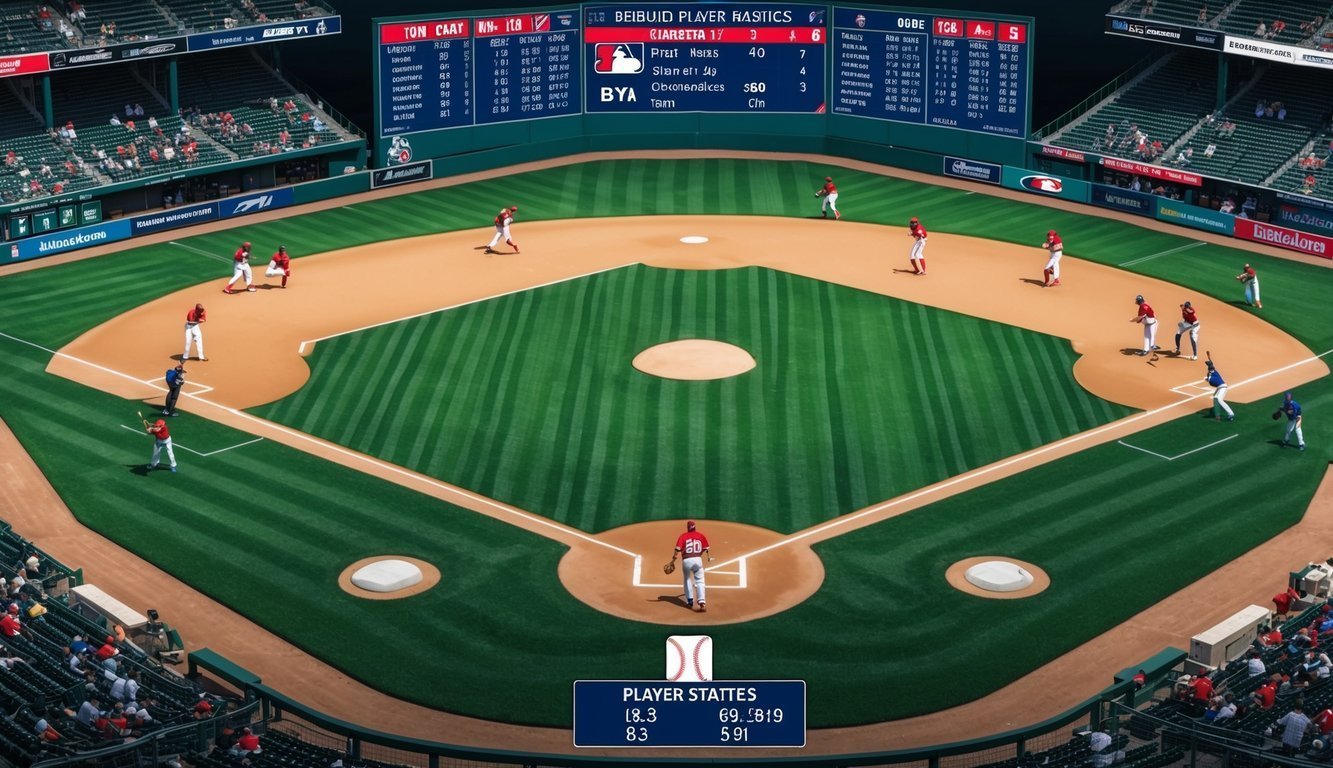Baseball enthusiasts and casual fans alike are always hungry for detailed statistics about their favorite players and teams.
Comprehensive baseball stats provide a wealth of information that goes far beyond basic averages and home run counts. In-depth metrics offer valuable insights into player performance, team strategies, and the overall dynamics of the game.
Major League Baseball (MLB) and various sports analytics companies have developed an extensive array of statistical categories to measure every aspect of the sport.
From traditional stats like batting average and earned run average to advanced metrics such as WAR (Wins Above Replacement) and OPS+ (On-base Plus Slugging Plus), there’s a number for nearly every facet of player and team performance.
These stats help teams make roster decisions, aid fantasy baseball players in drafting their squads, and give fans a deeper understanding of the game they love.
As the 2024 MLB season unfolds, fans can access a treasure trove of statistics through official league websites, specialized analytics platforms, and sports reference databases.
These resources allow users to compare players across different eras, analyze head-to-head matchups, and discover unique statistical achievements.
Whether you’re looking for the league leaders in batting average or curious about a pitcher’s spin rate, comprehensive baseball stats have you covered.
Fundamentals of Baseball Statistics
Baseball statistics form the backbone of understanding and analyzing the game.
They provide insights into player performance, team strategies, and historical comparisons.
History of Baseball Stats
Baseball’s love affair with numbers started in the late 19th century.
Henry Chadwick, often called the “Father of Baseball,” introduced the box score in the 1850s.
This simple grid captured basic game data like hits, runs, and outs.
As the sport evolved, so did its stats.
The batting average became popular in the 1870s.
By the early 1900s, RBIs and ERA joined the statistical lineup.
These metrics helped fans and teams evaluate players more objectively.
The computer age ushered in a new era of baseball statistics.
Advanced metrics like OPS emerged in the 1980s, offering deeper insights into player value.
Today, Statcast technology tracks everything from launch angles to spin rates.
Common Baseball Stats Explained
AB (At-Bats): The number of times a player bats, excluding walks and sacrifices.
HR (Home Runs): When a batter hits the ball over the outfield fence in fair territory.
RBI (Runs Batted In): The number of runs a player drives in with their hits.
AVG (Batting Average): Hits divided by at-bats, showing how often a player gets a hit.
ERA (Earned Run Average): The average number of earned runs a pitcher allows per nine innings.
SO (Strikeouts): For batters, times struck out.
For pitchers, batters struck out.
These stats form the foundation of player evaluation.
They appear on baseball cards, in broadcasts, and in casual fan discussions.
Understanding Advanced Metrics
OPS (On-Base Plus Slugging): Combines on-base percentage and slugging percentage.
It’s a more comprehensive measure of a batter’s offensive value.
WAR (Wins Above Replacement): Estimates a player’s total contribution to their team in one statistic.
FIP (Fielding Independent Pitching): Measures a pitcher’s effectiveness independent of their team’s defensive performance.
BABIP (Batting Average on Balls in Play): Shows how often a batter gets a hit when they put the ball in play.
These advanced stats offer a deeper understanding of player performance.
They account for factors traditional stats might miss, like ballpark effects or defensive contributions.
Teams use these metrics for player evaluation and strategy development.
Fans can dive into these numbers to enhance their appreciation of the game’s nuances.
Analyzing Player Performance
Baseball relies heavily on statistics to evaluate player performance across different aspects of the game.
These numbers provide insights into batting prowess, pitching effectiveness, and defensive skills.
Batting Statistics Breakdown
Key batting stats help assess a player’s offensive contributions.
Batting average (AVG) measures hit frequency, while on-base percentage (OBP) includes walks and hit-by-pitches.
Slugging percentage (SLG) reflects power hitting.
On-base plus slugging (OPS) combines OBP and SLG for a more comprehensive view.
Home runs (HR) and runs batted in (RBI) showcase a batter’s ability to drive in runs.
Advanced metrics like weighted on-base average (wOBA) account for the relative value of different offensive events.
A wOBA over .400 indicates an excellent hitter, while .340+ is above average.
Pitching Statistics Overview
Earned run average (ERA) is a fundamental pitching stat, measuring runs allowed per nine innings.
Wins and shutouts (SHO) reflect a pitcher’s ability to keep opposing teams from scoring.
Strikeouts (SO) demonstrate a pitcher’s dominance, while walks and hits per inning pitched (WHIP) show their control and ability to limit baserunners.
For starting pitchers, innings pitched and quality starts are important.
Fielding independent pitching (FIP) attempts to isolate a pitcher’s performance from factors outside their control.
Fielding and Defensive Metrics
Traditional fielding stats include errors and fielding percentage.
However, these don’t capture a player’s full defensive value.
Range factor measures the number of plays a fielder makes per game.
Ultimate zone rating (UZR) and defensive runs saved (DRS) attempt to quantify a player’s overall defensive contribution.
For catchers, metrics like caught stealing percentage and pitch framing skills are crucial.
Outfielders are evaluated on their arm strength and accuracy using metrics like outfield assists.
Major League Baseball Structure

Major League Baseball (MLB) consists of two leagues and six divisions.
The regular season determines playoff contenders, while the postseason crowns a champion through an elimination tournament.
The MLB playoffs explained reveal a structured format where the top teams from each league compete in a series of games, culminating in the World Series.
This intense competition not only showcases the skills of the players but also ignites the passion of fans as they rally behind their teams.
The postseason is a thrilling culmination of the months of hard work and dedication displayed throughout the regular season.
Leagues and Divisions
MLB is divided into the American League (AL) and National League (NL).
Each league has three divisions: East, Central, and West.
The AL and NL each have 15 teams, for a total of 30 MLB teams.
The AL East includes powerhouses like the New York Yankees and Boston Red Sox.
In the NL East, teams like the Atlanta Braves and Philadelphia Phillies compete.
The Central divisions feature teams such as the Chicago Cubs (NL) and Cleveland Guardians (AL).
Out west, the Los Angeles Dodgers (NL) and Houston Astros (AL) often dominate.
Understanding the Regular Season
The MLB regular season spans 162 games per team.
It typically runs from early April to late September or early October.
Teams play more games against division rivals, fostering intense competition.
During the season, teams aim to:
- Win their division
- Secure a wild card spot
- Improve their playoff odds
Standings are updated daily, reflecting each team’s wins and losses.
The team with the best record in each division advances to the playoffs.
Additional wild card teams also qualify based on their records.
Postseason Format and Impact on Stats
The MLB postseason is a thrilling tournament to determine the World Series champion.
It includes:
- Wild Card Series (best-of-three)
- Division Series (best-of-five)
- League Championship Series (best-of-seven)
- World Series (best-of-seven)
Playoff stats are tracked separately from regular season numbers.
Some players shine in October, earning reputations as clutch performers.
Others may struggle under postseason pressure.
Postseason success can greatly impact a player’s legacy and value.
It also affects team strategies, as managers often use their best pitchers more frequently in short series.
Team Dynamics and Strategies

Baseball teams are complex organisms, with success hinging on more than just individual talent.
The interplay between players, management decisions, and external factors shape a team’s performance and identity.
Roster Composition and Player Roles
MLB teams carefully craft their 26-man rosters to balance offense, defense, and pitching.
Each player fills a specific role, from everyday starters to specialized relievers and utility players.
Teams often mix veterans with young talent to foster mentorship and long-term success.
The minor league system plays a crucial part in developing future stars and providing depth.
Some teams prioritize power hitters, while others focus on speed and contact.
Defensive specialists can be game-changers, especially up the middle.
The Impact of Trades and Injuries
The trade deadline in July can dramatically alter a team’s fortunes.
Contenders often acquire star players to boost their playoff chances, while rebuilding teams stockpile prospects.
Injuries can derail even the most promising seasons.
Teams with strong depth and adaptable strategies tend to weather these challenges better.
Smart teams use advanced analytics to identify undervalued players in trades.
They also employ sophisticated injury prevention and rehabilitation programs.
Team Records and Achievements
Winning the World Series is the ultimate goal, but teams celebrate various milestones throughout the season.
Division titles, wild card berths, and All-Star selections recognize team and individual excellence.
Some teams chase historic records, like most wins in a season or longest winning streak.
These pursuits can energize fans and players alike.
The Hall of Fame immortalizes the game’s greatest players and managers.
Team success often leads to individual accolades, creating a virtuous cycle of achievement.
MLB standings track each team’s progress, with daily updates fueling fan engagement and strategic decisions by team management.
Resources for Baseball Enthusiasts

Baseball fans have access to a wealth of information and tools to enhance their understanding and enjoyment of the game.
From comprehensive statistical databases to prospect tracking systems, there’s something for every level of interest.
Where to Find the Latest Stats
MLB.com offers real-time statistics and box scores for every game.
Baseball-Reference provides an extensive historical database, allowing fans to compare players across eras.
FanGraphs is known for its advanced metrics and analytical tools.
For those who prefer mobile access, apps like ESPN and MLB At Bat deliver up-to-the-minute scores and stats.
Baseball Almanac serves as a digital encyclopedia, packed with records and trivia.
Stathead Baseball, a subscription service, offers powerful search capabilities for diving deep into baseball data.
It’s particularly useful for researchers and serious fans looking to uncover unique insights.
Following Minor League Prospects
MiLB.com is the official site for minor league statistics and news.
It provides live game updates, player profiles, and team information across all levels of the minors.
Baseball America focuses on prospect rankings and scouting reports.
Their coverage is essential for fans interested in the future stars of the game.
The Baseball Cube offers a comprehensive database of minor league stats, including college and international leagues.
It’s an invaluable resource for tracking player development over time.
Utilizing Fantasy Baseball and Betting Information
Fantasy baseball platforms like Yahoo, ESPN, and CBS Sports offer player projections, injury updates, and daily matchup analysis.
These tools help fantasy managers make informed decisions about their lineups.
For those interested in baseball betting, sites like FanDuel and DraftKings provide odds and prop bets.
They also offer daily fantasy contests with real-time scoring.
RotoWire specializes in fantasy baseball news and analysis.
Their expert insights can give players an edge in both season-long leagues and daily contests.
Baseball Prospectus combines statistical analysis with fantasy baseball advice.
Their PECOTA projections are widely respected in both fantasy and analytical circles.
